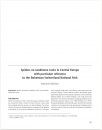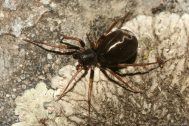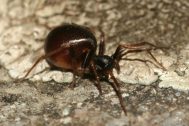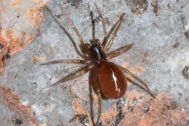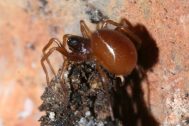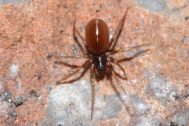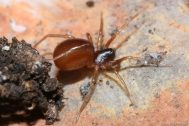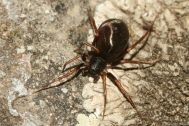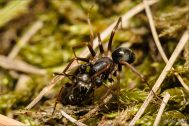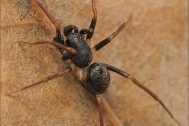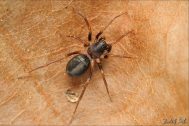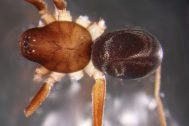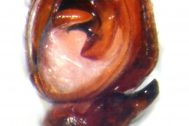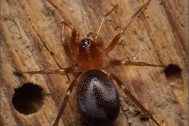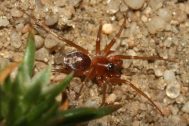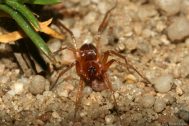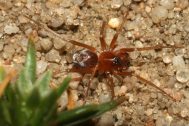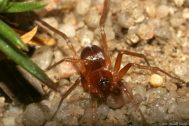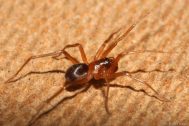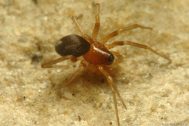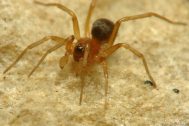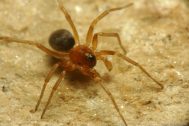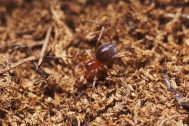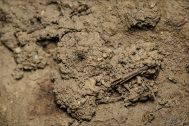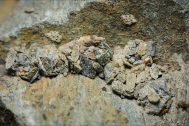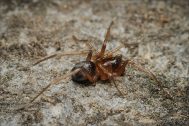| Records by time | |||||
|---|---|---|---|---|---|
| Zodariidae | 0-1900 | 1901-1950 | 1951-2000 | 2001+ | ∑ |
 Zodarion germanicum
(C. L. Koch, 1837) Not endangered Zodarion germanicum
(C. L. Koch, 1837) Not endangered |
1× | 1× | 168× | 161× | 331× |
 Zodarion italicum
(Canestrini, 1868) Not endangered Zodarion italicum
(Canestrini, 1868) Not endangered |
2× | 17× | 19× | ||
 Zodarion ohridense
Wunderlich, 1973 Zodarion ohridense
Wunderlich, 1973 |
1× | 1× | |||
 Zodarion rubidum
Simon, 1914 Not endangered Zodarion rubidum
Simon, 1914 Not endangered |
21× | 124× | 145× | ||
Bibliography
Ant‐eating spider maintains specialist diet throughout its ontogeny.
Predators should be selected to maximize their fitness by catching the most profitable prey. As predators grow in size, they often shift their preferences to larger prey during the course of development. Alike generalist predators, specialized predators should also shift to larger prey within the pool of focal prey. Here, we have studied the natural diet of a specialized ant‐eating spider Zodarion rubidum by means of molecular methods. We tested the hypothesis of a trophic shift during postembryonic ontogenesis and if there is a difference in the diet between sexes due to sexual dimorphism. In addition, a feeding trial was performed to estimate the time at which prey DNA can be detected. The diet of all stages consisted solely of ants (nine genera), thus confirming their strict ant specialization. There was no shift in prey size or prey type during ontogenetic development, but the diversity of prey declined with age. In adult males, very few prey were detected. The feeding trial showed that prey DNA can be detected inside the spider’s gut up to 2 weeks after feeding.Pavouci (Araneae) CHKO Brdy.
Spiders of the Brdy Protected Landscape Area were studied. Material obtained from pitfall traps exposed during the years 2016–2017 at 15 different representative localities included a total of 4027 individuals belonging to 154 species of spiders. Cold tolerant species (e.g. Bathyphantes similis and Pocadicnemis carpatica) as well as thermophilic species (e.g. Lathys humilis and Zodarion germanicum) were recorded. The West European species Palliduphantes ericaeus reaches here the easternmost border of its distribution, on the contrary the East European species Walckenaeria simplex has in this territory the western limit of its areal. A quarter of the recorded spider species is closely related to the original and natural habitats. Together with the published data and data from arachnological databases, the occurrence of 220 species of spiders is currently listed for the Brdy PLA, representing about 25 % of the total fauna of the Czech Republic. The results documented presence of interesting arachnofauna and confirm a high natural value of the given area.
Zodarion ohridense (Araneae: Zodariidae) – a new record for Central Europe.
Zodarion ohridense Wunderlich, 1973 was found to be introduced in an abandoned stone quarry near Kolín in the Czech Republic. The Central European species of Zodarion are discussed.Pavouk 41 (12/2016)
Pavouci České republiky; Skálovka Hermanova Zelotes hermani (Chyzer, 1897) – nový druh v ČR; Erigone cristatopalpus Simon, 1884; Mravčík ohridský (Zodarion ohridense Wunderlich, 1973) (Araneae: Zodariidae) – nový druh pro Českou republiku; Něco málo ze ZOO Praha: Modisimus culicinus (Simon, 1893); Kamenožrout zelený III; Významné nálezy pavouků z ČR II./ Remarkable records of spiders from Czech Republic II.; Skákavka ryšavonohá Ballus rufipes (Simon, 1868) (Araneae: Salticidae) – nový druh pro Slovenskou republiku; Inventarizace 2015; Co se skrývá v kokonech?; 114. seminář České arachnologické společnosti – Olomouc; 20th International Congress of Arachnology; Kroniky; Sedmdesáté narozeniny Antonína Kůrky; Bucharova mísa plná pavouků; Náš táta pavouk; Česká arachnologická bibliografie; Britská bibliografie – The Newsletter 136 a 137; Nové knihy;Invertebrates of the Macocha Abyss (Moravian Karst, Czech Republic).
The invertebrates of the Macocha Abyss, Moravian Karst, Czech Republic, were collected in 2007–2008 and 222 species were identified in total. The relative abundance of individual taxa of land snails, harvestmen, pseudoscorpions, spiders, millipedes, centipedes, terrestrial isopods, beetles, and ants was evaluated. The cold-adapted mountain and subterranean species inhabit the bottom and lower part of the abyss, whereas the sun-exposed rocky margins were inhabited by thermophilous species. Macocha harbors several threatened species that are absent or very rare in the surrounding habitats. In the forest landscape, the Macocha Abyss represents a natural habitat with a distinct microclimatic gradient, and is an excellent refuge area for psychrophilous as well as thermophilous species, which significantly contributes to maintenance of landscape biodiversity.
Dietary and prey-capture adaptations by which Zodarion germanicum, an ant-eating spider (Araneae: Zodariidae), specialises on the Formicinae
Spiders on sandstone rocks in Central Europe with particular reference to the Bohemian Switzerland National Park.
While the majority of the Central European landscape would be covered by forests without human influence, rocky areas form isolated, islet-like, natural, non-forest habitats. The surface of some of these non-forested areas is composed of bare bedrock or products of its erosional breakdown (without a soil layer) such as gravel, sand banks, sand dunes, scree slopes and rock outcrop habitats. These habitats harbour specialized spider species that depend on their specific substratum and microclimate (Růžička 2000). Out of these habitats, rock walls (and scree slopes) form one of the most distinct ecological gradients of any terrestrial ecosystem (Larson et al. 1989, Růžička et al. 1995). They provide habitats with extremely warm and cold microclimatic conditions in close proximity. They also belong to habitats almost unknown until now due to the technical and practical problems of sampling.
Sandstones can form extensive systems of rocks, sometimes with a broad spectrum of meso- and microhabitats due to their very dynamic relief. Sandstone rocks are characterised by a marked contrast between forested plateau and bare vertical rock walls (Balatka and Sládek 1984). Upper margins of rocks are dry, vertical rock walls can be sun-exposed, dry and bare, or shady and humid and hence covered by mosses. Spaces with an extremely cold climate can occur in deep gorges. The aim of this study is to evaluate available data on the species composition of spider assemblages in sandstone rocks, including new data about spiders on rock walls in the Bohemian Switzerland (České Švýcarsko) National Park.
Geographical sexual size dimorphism in an ant-eating spider, Zodarion rubidum (Araneae: Zodariidae)
Comparison of natural histories and karyotypes of two closely related ant-eating spiders, Zodarion hamatum and Z. italicum (Araneae, Zodariidae)
Gallery
Zodarion germanicum
Zodarion ohridense
Zodarion rubidum
Statistics
By month
By altitude
By collecting method (494 used records)
| Zemní past | Males | Females | Juveniles | Records |
|---|---|---|---|---|
| Zodarion germanicum (C. L. Koch, 1837) | 562 | 217 | 649 | 218 |
| Zodarion italicum (Canestrini, 1868) | 77 | 65 | 0 | 14 |
| Zodarion ohridense Wunderlich, 1973 | 1 | 0 | 0 | 1 |
| Zodarion rubidum Simon, 1914 | 476 | 170 | 2 | 82 |
| Neurčeno | Males | Females | Juveniles | Records |
| Zodarion germanicum (C. L. Koch, 1837) | 86 | 21 | 0 | 72 |
| Zodarion italicum (Canestrini, 1868) | 1 | 0 | 0 | 1 |
| Zodarion rubidum Simon, 1914 | 2 | 4 | 0 | 23 |
| Individuální sběr | Males | Females | Juveniles | Records |
| Zodarion germanicum (C. L. Koch, 1837) | 17 | 17 | 5 | 32 |
| Zodarion italicum (Canestrini, 1868) | 3 | 3 | 0 | 2 |
| Zodarion rubidum Simon, 1914 | 8 | 24 | 5 | 25 |
| Prosev | Males | Females | Juveniles | Records |
| Zodarion germanicum (C. L. Koch, 1837) | 18 | 3 | 3 | 8 |
| Zodarion rubidum Simon, 1914 | 1 | 3 | 37 | 8 |
| Smyk | Males | Females | Juveniles | Records |
| Zodarion germanicum (C. L. Koch, 1837) | 1 | 0 | 0 | 1 |
| Zodarion italicum (Canestrini, 1868) | 6 | 4 | 0 | 2 |
| Zodarion rubidum Simon, 1914 | 1 | 1 | 0 | 1 |
| Pozorování | Males | Females | Juveniles | Records |
| Zodarion rubidum Simon, 1914 | 7 | 8 | 0 | 4 |
| Males | Females | Juveniles | Records |
By biotope (495 used records)
| Neurčeno | Males | Females | Juveniles | Records |
|---|---|---|---|---|
| Zodarion germanicum (C. L. Koch, 1837) | 269 | 133 | 18 | 156 |
| Zodarion italicum (Canestrini, 1868) | 75 | 67 | 0 | 14 |
| Zodarion rubidum Simon, 1914 | 307 | 136 | 4 | 76 |
| Kamenolomy | Males | Females | Juveniles | Records |
| Zodarion germanicum (C. L. Koch, 1837) | 29 | 8 | 0 | 10 |
| Zodarion ohridense Wunderlich, 1973 | 1 | 0 | 0 | 1 |
| Zodarion rubidum Simon, 1914 | 114 | 23 | 1 | 13 |
| Lesostepní doubravy | Males | Females | Juveniles | Records |
| Zodarion germanicum (C. L. Koch, 1837) | 72 | 17 | 12 | 24 |
| Suché doubravy | Males | Females | Juveniles | Records |
| Zodarion germanicum (C. L. Koch, 1837) | 27 | 9 | 4 | 20 |
| Suché louky | Males | Females | Juveniles | Records |
| Zodarion germanicum (C. L. Koch, 1837) | 15 | 13 | 0 | 11 |
| Zodarion rubidum Simon, 1914 | 3 | 7 | 4 | 9 |
| Skalní stepi na vápenci | Males | Females | Juveniles | Records |
| Zodarion germanicum (C. L. Koch, 1837) | 18 | 12 | 20 | 18 |
| Zodarion italicum (Canestrini, 1868) | 1 | 0 | 0 | 1 |
| Lesní okraje | Males | Females | Juveniles | Records |
| Zodarion germanicum (C. L. Koch, 1837) | 80 | 7 | 1 | 15 |
| Kamenité suti nižších poloh | Males | Females | Juveniles | Records |
| Zodarion germanicum (C. L. Koch, 1837) | 9 | 6 | 2 | 12 |
| Stinné skály nižších poloh | Males | Females | Juveniles | Records |
| Zodarion germanicum (C. L. Koch, 1837) | 6 | 4 | 3 | 8 |
| Zodarion rubidum Simon, 1914 | 1 | 0 | 0 | 1 |
| Ruderály | Males | Females | Juveniles | Records |
| Zodarion germanicum (C. L. Koch, 1837) | 2 | 0 | 0 | 1 |
| Zodarion rubidum Simon, 1914 | 5 | 11 | 0 | 6 |
| Těžebny písku a jiných nezpevněných hornin | Males | Females | Juveniles | Records |
| Zodarion rubidum Simon, 1914 | 11 | 10 | 0 | 7 |
| Haldy a výsypky | Males | Females | Juveniles | Records |
| Zodarion germanicum (C. L. Koch, 1837) | 0 | 0 | 589 | 4 |
| Zodarion rubidum Simon, 1914 | 6 | 2 | 0 | 3 |
| Xerotermní travinobylinná společenstva | Males | Females | Juveniles | Records |
| Zodarion germanicum (C. L. Koch, 1837) | 3 | 4 | 3 | 4 |
| Zodarion italicum (Canestrini, 1868) | 2 | 3 | 0 | 1 |
| Zodarion rubidum Simon, 1914 | 2 | 0 | 0 | 1 |
| Výsadby jehličnanů | Males | Females | Juveniles | Records |
| Zodarion germanicum (C. L. Koch, 1837) | 3 | 4 | 0 | 5 |
| Okraje silnic | Males | Females | Juveniles | Records |
| Zodarion germanicum (C. L. Koch, 1837) | 41 | 14 | 5 | 3 |
| Zodarion rubidum Simon, 1914 | 10 | 0 | 0 | 2 |
| Písčiny | Males | Females | Juveniles | Records |
| Zodarion rubidum Simon, 1914 | 5 | 2 | 0 | 5 |
| Železniční náspy | Males | Females | Juveniles | Records |
| Zodarion rubidum Simon, 1914 | 1 | 1 | 35 | 5 |
| Rašelinné bory | Males | Females | Juveniles | Records |
| Zodarion germanicum (C. L. Koch, 1837) | 4 | 1 | 0 | 4 |
| Reliktní bory na skalách | Males | Females | Juveniles | Records |
| Zodarion germanicum (C. L. Koch, 1837) | 6 | 2 | 0 | 4 |
| Suché křoviny | Males | Females | Juveniles | Records |
| Zodarion germanicum (C. L. Koch, 1837) | 4 | 0 | 0 | 3 |
| Zodarion italicum (Canestrini, 1868) | 6 | 1 | 0 | 1 |
| Dubohabřiny | Males | Females | Juveniles | Records |
| Zodarion germanicum (C. L. Koch, 1837) | 13 | 4 | 0 | 4 |
| Suťové a roklinové lesy | Males | Females | Juveniles | Records |
| Zodarion germanicum (C. L. Koch, 1837) | 6 | 3 | 0 | 4 |
| Travnaté stepi | Males | Females | Juveniles | Records |
| Zodarion rubidum Simon, 1914 | 5 | 2 | 0 | 3 |
| Paseky | Males | Females | Juveniles | Records |
| Zodarion germanicum (C. L. Koch, 1837) | 3 | 0 | 0 | 2 |
| Zodarion rubidum Simon, 1914 | 0 | 1 | 0 | 1 |
| Nehluboké podzemní prostory (pukliny, půdní horizonty) | Males | Females | Juveniles | Records |
| Zodarion italicum (Canestrini, 1868) | 3 | 1 | 0 | 2 |
| Zodarion rubidum Simon, 1914 | 2 | 0 | 0 | 1 |
| Výsadby listnáčů | Males | Females | Juveniles | Records |
| Zodarion germanicum (C. L. Koch, 1837) | 56 | 11 | 0 | 3 |
| Louky | Males | Females | Juveniles | Records |
| Zodarion germanicum (C. L. Koch, 1837) | 4 | 3 | 0 | 3 |
| Suché lesní lemy | Males | Females | Juveniles | Records |
| Zodarion germanicum (C. L. Koch, 1837) | 2 | 0 | 0 | 2 |
| Vřesoviště nižších poloh | Males | Females | Juveniles | Records |
| Zodarion rubidum Simon, 1914 | 11 | 6 | 0 | 2 |
| Skalní stepi na jiných horninách | Males | Females | Juveniles | Records |
| Zodarion germanicum (C. L. Koch, 1837) | 2 | 0 | 0 | 1 |
| Zodarion rubidum Simon, 1914 | 0 | 1 | 0 | 1 |
| Antropická společenstva | Males | Females | Juveniles | Records |
| Zodarion germanicum (C. L. Koch, 1837) | 0 | 1 | 0 | 1 |
| Zodarion rubidum Simon, 1914 | 0 | 1 | 0 | 1 |
| Lužní lesy nížin | Males | Females | Juveniles | Records |
| Zodarion germanicum (C. L. Koch, 1837) | 2 | 0 | 0 | 2 |
| Nízké xerofilní křoviny | Males | Females | Juveniles | Records |
| Zodarion rubidum Simon, 1914 | 10 | 2 | 0 | 2 |
| Acidofilní bory | Males | Females | Juveniles | Records |
| Zodarion germanicum (C. L. Koch, 1837) | 1 | 0 | 0 | 1 |
| Lesy | Males | Females | Juveniles | Records |
| Zodarion rubidum Simon, 1914 | 0 | 0 | 0 | 1 |
| Přirozené lesy | Males | Females | Juveniles | Records |
| Zodarion germanicum (C. L. Koch, 1837) | 1 | 0 | 0 | 1 |
| Jeskyně | Males | Females | Juveniles | Records |
| Zodarion rubidum Simon, 1914 | 0 | 2 | 0 | 1 |
| Porosty borůvek | Males | Females | Juveniles | Records |
| Zodarion germanicum (C. L. Koch, 1837) | 0 | 0 | 0 | 1 |
| Skály a sutě v horách | Males | Females | Juveniles | Records |
| Zodarion germanicum (C. L. Koch, 1837) | 0 | 1 | 0 | 1 |
| Bučiny nižších poloh | Males | Females | Juveniles | Records |
| Zodarion germanicum (C. L. Koch, 1837) | 1 | 0 | 0 | 1 |
| Mokřady | Males | Females | Juveniles | Records |
| Zodarion germanicum (C. L. Koch, 1837) | 1 | 0 | 0 | 1 |
| Ostatní pole | Males | Females | Juveniles | Records |
| Zodarion rubidum Simon, 1914 | 1 | 0 | 0 | 1 |
| Bylinné porosty břehů | Males | Females | Juveniles | Records |
| Zodarion rubidum Simon, 1914 | 0 | 0 | 0 | 1 |
| Zahrady | Males | Females | Juveniles | Records |
| Zodarion rubidum Simon, 1914 | 2 | 3 | 0 | 1 |
| Stojaté a pomalu tekoucí vody | Males | Females | Juveniles | Records |
| Zodarion germanicum (C. L. Koch, 1837) | 4 | 1 | 0 | 1 |
| Males | Females | Juveniles | Records |






